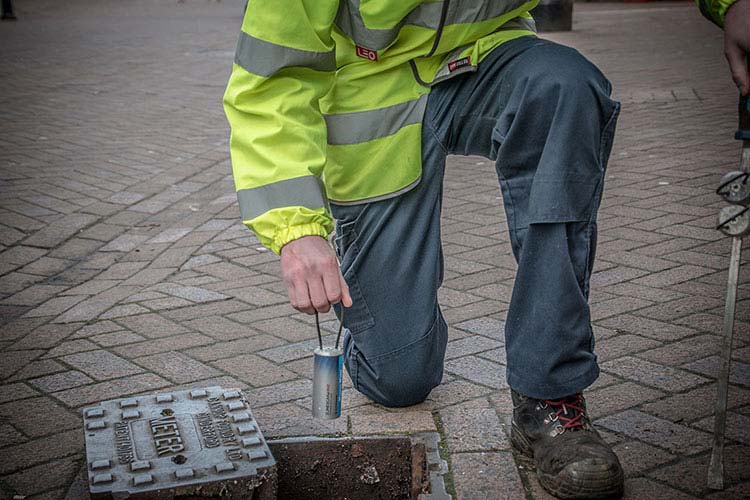- Marketplace
- Challenges
- Acoustic leak detection
Challenge update Autumn 2021: We received some interesting submissions for this challenge and explored several options. Unfortunately we were unable to take things further due to changes in the business, but will bear the suppliers who participated in mind should the need re-emerge.
Background
Wessex Water is able to deploy up to 800 acoustic loggers a day as part of our ongoing leakage detection. These devices log noise levels throughout a predetermined period of the night (usually 2:00-4:00 am), recording a sound file that the loggers use for spectrum analysis.
This data is reviewed, including cross-referencing between multiple loggers, in order to identify points of interest (POIs) which are investigated by leakage inspectors.
Over the last 4 years, 232,000 logger movements have been carried out, resulting in finding more than 2,800 leaks. Currently we have a 60% success rate of leaks found from POIs issued to leakage inspectors.
We want to engage suppliers to carry out proof of concept (POC) trials to demonstrate the value of applying machine-learning algorithms to the data in order to improve this success rate.

What are we looking for?
To further improve the success rate of leaks found from POIs issued, we’d like to increase the efficiency of our current process for generating POIs as described below:
- The acoustic information generated from a logger, including a leak score, is downloaded from the Gutermann Cloud to Wessex Water systems.
- Internal leakage analysts use this data to assess the likelihood of a leak. Typically they review any files with a minimum decibel reading of 10 to determine whether the file indicates a POI. The analytical software also identifies “correlations” which are POIs located between multiple loggers that are detecting the same noise at the same time. These are manually reviewed and corrected where required.
- Verification steps include listening to the sound recording from the loggers to ensure that only leak-type sound is progressed, cross-referencing the location of the ‘leak noise’ with network assets such as pressure reducing valves (PRVs), pumps, etc, that may have been causing the noise rather than a genuine leak, and reviewing whether multiple POIs that the software may have generated in the same area are a single leak or multiple leaks.
- This information is all recorded, and a file is built for leakage inspectors to complete as they investigate the POI.
We’d like to determine whether it is possible to further improve the success rate and prioritise the leaks identified in a more automated manner to improve the efficiency of the analysts. This would be based on the acoustic data, pipe material and its environment. Ideally this would:
- help us to better prioritise the POIs sent out for investigation by leakage inspectors
- improve the likelihood of leakage detection
- reduce the level of manual analysis that is carried out thereby lowering the chance of human error
- reduce the number of false positives
- if possible, estimate a m3/hr figure for the leak
- provide a greater insight on our current data sets
We would like to understand whether a smart algorithm-based tool exists that can provide a level of decision support, by applying machine-learning techniques to data from the loggers, our mains and associated environment conditions.
We are looking to engage with the market to identify providers who are able to run proof of concept (POC) trials (phase 2). We are proposing to run up to two POCs.
What must the solution provide?
We are looking for a solution that improves our success rate of leaks found from POIs issued, minimises the number of false positives and improves the confidence of the POI.
How to get involved
We will be having a Skype session on the 16 January, 1:15-2:15pm UK time. Interested parties wanting to join should register via email marketplace@wessexwater.co.uk
When requesting a place on the call, please provide a brief summary (max 250 words) of your expertise in this area. In previous challenges we have received high levels of interest and depending on the numbers this time we may need to limit engagement to ensure we can fully engage with those who are involved. If this is the case, we will review suppliers’ expertise to produce a shortlist.
Suppliers will then have until the 14 February to submit their proposals for a POC.
Proposals should include:
- a completed response to our minimum supplier obligations.
- details of the system that you propose to use, and any case studies of previous use
- demonstrations of the system outputs based on our data (which can be found here Leakage acoustic logger data)
- confirmation that the solution is available for purchase and implementation following a successful POC and indicative costs
- compatibility with Gutermann and Microsoft Azure.
We will review the proposals and identify who we would like to take forward to POC stage. Suppliers involved in the POC stage will, amongst other things, be asked to complete our cyber security questionnaire. Feedback will be provided to all suppliers. Timescales for this will be advised after the 14 February when we know how many proposals we have received.
